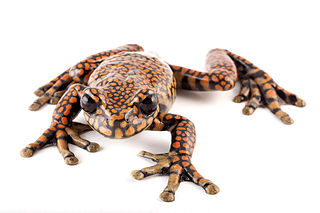
Hyloscirtus is a genus of Neotropical frogs in the family Hylidae. This genus was resurrected in 2005 following a major revision of the Hylidae, with the distinguishing features being 56 transformations in nuclear and mitochondrial proteins and ribosomal genes. Of these species, 28 species, previously placed in the genus Hyla, were moved to this genus. The fingers and toes of these frogs have wide dermal fringes.
Hyloscirtus bogotensis, called Bogota tree frog in English, is a species of frog in the family Hylidae endemic to Colombia. It has been observed between 1750 and 3600 meters above sea level.
The Sardinata tree frog is a species of frogs in the family Hylidae endemic to Colombia. Its natural habitats are subtropical or tropical moist montane forests, rivers, pastureland, plantations, rural gardens, and heavily degraded former forests. Scientists have seen it between 1050 and 3000 meters above sea level. It is threatened by habitat loss.
The Cauca tree frog is a species of frog in the family Hylidae. Endemic to Colombia, its natural habitats are subtropical or tropical moist montane forests and rivers. Scientists have seen it between 2400 and 2720 meters above sea level. The frog is threatened by habitat loss.

The Charta tree frog is a species of frog in the family Hylidae. Endemic to Colombia, its skin is green, and it may have black speckles along its spine. Its natural habitats are subtropical or tropical moist montane forests and rivers in the Sub-Andean forests of the foothills of the Cordilleras associated with the Middle Magdalena Valley in the Antioquia Department. It is threatened by habitat loss, agriculture, and livestock ranching.

The Cordillera central tree frog is a species of frog in the family Hylidae found in Colombia and Ecuador. Its natural habitats are subtropical or tropical moist montane forests and rivers. It is threatened by habitat loss. While living, this creature has a solid brown dorsum, and its concealed limbs and underbelly are blue with black spots. The younger frogs are a grayish brown with some darker markings. The younger frogs' concealed limbs and underbellies are a creamy color.
Linda's tree frog is a species of frog in the family Hylidae found in Colombia and Ecuador between 2000 and 2500 meters above sea level. Its natural habitats are subtropical or tropical moist montane forests, rivers, pastureland, rural gardens, and heavily degraded former forests. It is threatened by habitat loss.
Lynch's Colombian tree frog is a species of frog in the family Hylidae endemic to Colombia. Its natural habitats are subtropical or tropical moist montane forests and rivers. Scientists have seen it between 2540 and 2700 meters above sea level. It is threatened by habitat loss.
The Rio Luisito tree frog is a species of frog in the family Hylidae endemic to Colombia. Its natural habitats are subtropical or tropical moist montane forests and rivers. It has been observed between 1750 and 2000 meters above sea level. It is threatened by habitat loss.
The Papallacta tree frog is a species of frog in the family Hylidae found in Colombia and Ecuador. Its natural habitats are subtropical or tropical moist montane forests and rivers. Scientists have seen it between 1950 and 2660 meters above sea level in the Cordillera Oriental. It is threatened by habitat loss.
The Pilalo tree frog is a species of frog in the family Hylidae endemic to Ecuador. Its natural habitats are subtropical or tropical moist montane forests and rivers. It has been observed between 2300 and 2600 meters above sea level. It is threatened by habitat loss.
The western Andes tree frog is a species of frog in the family Hylidae endemic to Colombia. Its natural habitats are subtropical or tropical moist montane forests and rivers. It has been observed at 2190 meters above sea level. It is threatened by habitat loss.
The Jondachi tree frog is a species of frogs in the family Hylidae endemic to Ecuador. Its natural habitats are subtropical or tropical moist montane forests and rivers. Scientists have seen it between 2040 and 2500 meters above sea level. It is threatened by habitat loss.
The El Pepino tree frog is a species of frog in the family Hylidae found in Colombia and Ecuador. Its natural habitats are subtropical or tropical moist lowland forests, subtropical or tropical moist montane forests, rivers, and swamps. It is threatened by habitat loss.

The Prince Charles stream tree frog is a species of frogs in the family Hylidae found in Ecuador. It is considered an endangered species threatened by habitat loss, climate change, pathogens, and other hazards.

Hyloscirtus hillisi is a species of tree frog native to the Cordillera del Cóndor in Ecuador at elevations of 6,532 to 7,001 feet. The species is in danger of extinction.

Hyloscirtus condor is a species of tree frog native to Ecuador. Scientists know it exclusively from the type locality in the Reserva Biológica Cerro Plateado. It can be found in elevations of more than 2,300 m (7,500 ft).
Hyloscirtus tigrinus is a species of tree frog native to Colombia and Ecuador. It can be found in elevations of up to 3000 meters up in the Andes Mountains. Scientists have observed the frog sitting on vegetation approximately .5 m above ground level.
Hyloscirtus criptico is a species of tree frog native to Ecuador. It can be found in forests in the Andes at elevations of 2175–2794 meters.
Hyloscirtus antioquia is a species of frogs in the family Hylidae.





